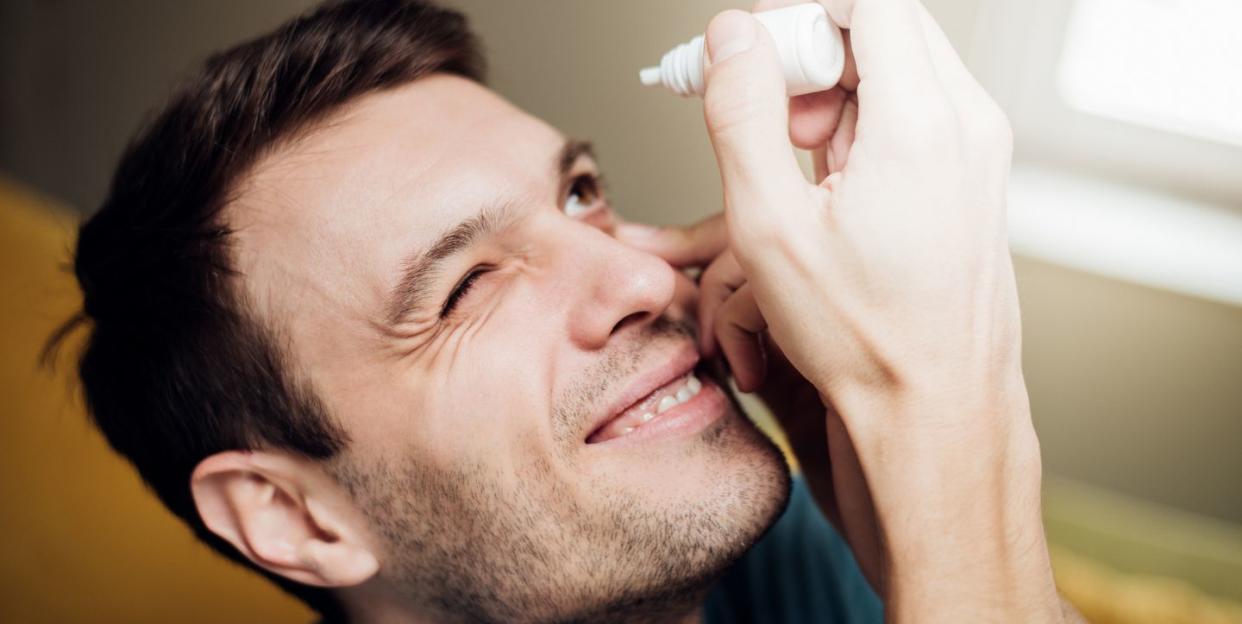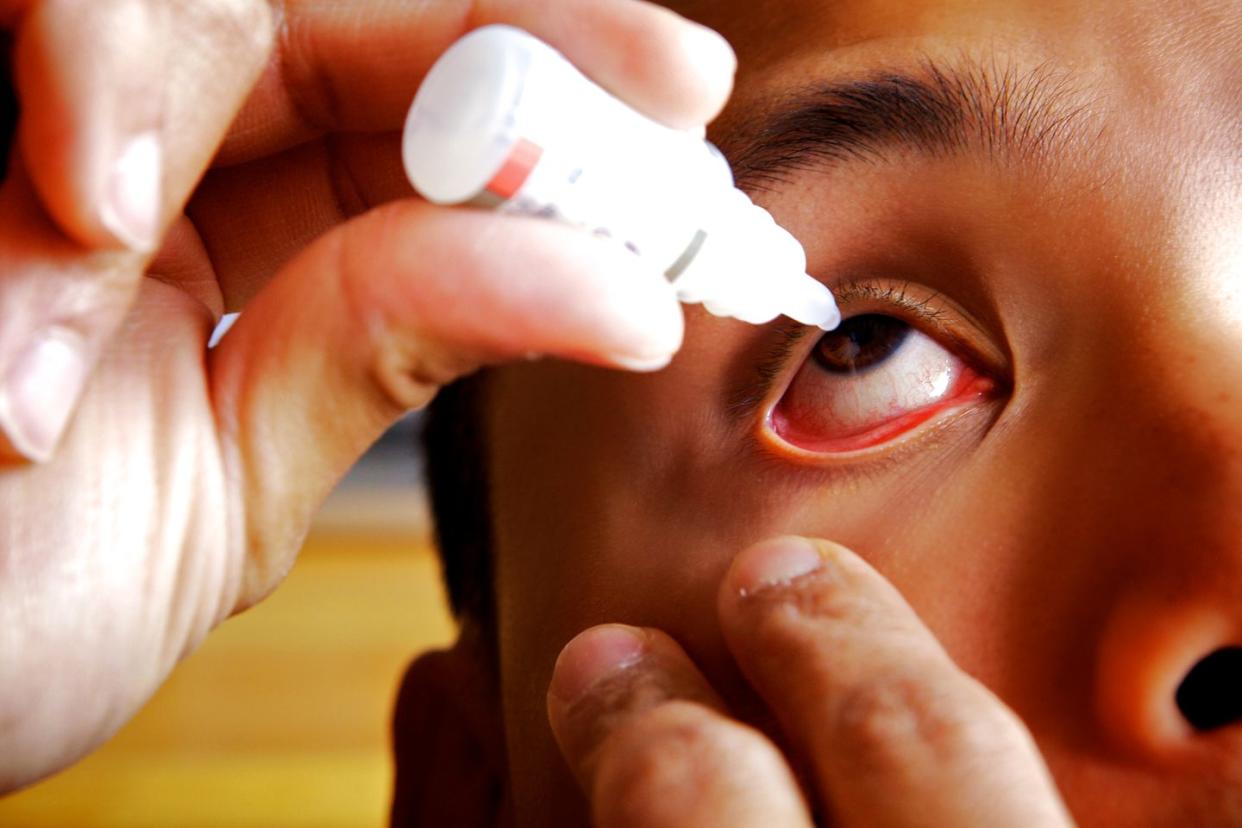The Best Eye Drops for Allergy Relief

"Hearst Magazines and Yahoo may earn commission or revenue on some items through the links below."
Sometimes, your seasonal allergies are pretty well under control—you’re taking your meds regularly and you’re not sneezing up a storm. But your eyes are still itchy and red. Other times, you seem to have no symptoms of seasonal allergies at all—no feeling fuzzy, no stuffed or runny nose—yet your eyes get super itchy, red or puffy when you’ve been outdoors. Maybe they tear up or get watery, too.
And in other cases, eye allergies aren’t related to seasonal allergies at all. Allergic conjunctivitis, as doctors call it, can occur at any time of year, sometimes due to dust mites or animal dander.
Many allergy sufferers find that taking their oral meds or nasal steroid spray controls the eye symptoms. But sometimes they don’t, and allergy eye drops might help. One of the benefits of eye drops for allergic eye symptoms is that “they have a quick onset of action,” explains Courtney Jackson Blair, M.D., vice president of the Greater Washington Allergy, Asthma and Immunology Society and owner of Allergy and Asthma Associates in Virginia. So you feel relief—and stop rubbing your eyes—without too much delay.
There are many allergy eye drops at the drugstore and available by prescription. Here’s how to navigate the options.
Over-The-Counter Allergy Eye Drops
On the shelf at your drugstore, you’ll generally find two types of products: Those containing antihistamines or mast cell stabilizers, and those containing a combination of drugs called pheniramine maleate and naphazoline hydrochloride. It’s a mouthful, but here’s what to know about each, plus what to know about prescription eye drops.
As for which one’s the best for you? That can be hard to predict. “We have no markers of an individual that will determine which drug is best for them,” says Leonard Bielory, MD, professor of medicine, allergy, immunology, and ophthalmology at Hackensack Meridian School of Medicine. The good news is that many medicines work through similar mechanisms to provide relief.
Eye drops containing ketotifen
This drug is an antihistamine, meaning it blocks symptoms by blocking receptors for histamine, a chemical that you make during an allergic reaction that causes those familiar allergy symptoms. It’s also what’s called a mast cell stabilizer, which means it blocks chemicals including histamine from being produced in the first place. Relief lasts up to 12 hours.
Find ketotifen in products including Zaditor, Alaway, and CVS Health Eye Itch Relief.
Eye drops containing olopatadine
Olopatadine is a once-a-day mast cell stabilizer eye drop that was available by prescription only until 2020; now it’s in products you can purchase over the counter. The active ingredient also has antihistamine effects. “That was kind of my go-to prescription medication for many, many years in patients who I saw who had allergic conjunctivitis,” said Christopher E. Starr, M.D., associate professor of ophthalmology and director of ophthalmic education at Weill Cornell Medicine. Olopatadine treats the acute allergy through its antihistamine effect and helps to prevent or decrease subsequent allergic responses to allergens by stabilizing the mast cells, he said.
Find olopatadine in Pataday and Equate Olopatadine 0.2% Ophthalmic Eye Drops for Eye Allergy Itch Relief and Dry Eyes.
Eye drops containing alcaftadine
Alcaftadine is a once-a-day antihistamine eye drop that was available by prescription only until 2021; now it’s available in OTC drops.
Find alcaftadine in Lastacaft.
Eye drops containing pheniramine maleate and naphazoline hydrochloride
We’re not expecting you to remember those names, so bookmark this page when you go to the drugstore so you can match them to the products on the shelf that contain them. This is a combination of antihistamine (pheniramine maleate) and decongestant (naphazoline hydrochloride).
The only challenge with decongestants, which act as redness reducers, is that “sometimes the redness reducer will cause a rebound effect,” says Dr. Jackson Blair. “The redness can come back worse than it was before.” Also, eye drops with a decongestant can increase eye pressure, so patients with glaucoma should avoid this group of eye drops.
Find pheniramine maleate and naphazoline hydrochloride in Naphcon A, Visine Allergy Eye Relief Multi-Action, and Walgreen’s Eye Allergy Relief.
Prescription allergy eye drops
There are a whole host of options in prescription eye drops, from mast cell inhibitors to antihistamines of different types. If your eyes aren’t easily soothed by over-the-counter problems, it’s worth seeing an allergist. One of the many reasons—not just so you get the right drops—is that they can help you figure out what specifically is causing the reaction and you can try to reduce your exposure to it. Allergy symptoms can be caused by many triggers, from pollens to animal dander to mold and more.

An ophthalmologist can also help you suss out whether additional eye problems are contributing to your discomfort.
“These ocular surface symptoms—redness, itching, burning, stinging, tearing, dryness—those are very common symptoms that overlap with a lot of other ocular surface diseases like dry eye, meibomian gland dysfunction, blepharitis, a whole bunch of things,” says Dr. Starr. “So I do think it is important to have a confirmed diagnosis because these allergy drops won't work a whole lot if your actual problem is dry eye disease or blepharitis or something else.”
Finally, in limited instances, a prescription steroid (such as Alrex or Lotemax) may be used for more severe symptoms of allergic conjunctivitis. Steroids however, should be used cautiously as they can also increase the risk for glaucoma and cataracts. If used for more than a week it is advisable to also have an optometrist or ophthalmologist assist in the management, explains Kirk Waibel, M.D., former Allergy Consultant to the Army Surgeon General, now at Aspire Allergy & Sinus in San Antonio, TX.
Tips for using allergy eye drops
Use these tips from the doctors to get the most from the allergy eye drops you use:
Check with your eye doctor about how to use prescription meds, and read OTC labels carefully regarding dosage and how many times a day you need to use the drops, says Dr. Waibel.
Ask or read the label to see if the drops can be used with contact lenses. Some can, but you may have to adjust your lens-wearing schedule, since you need to wait ten to 15 minutes after using the drops before putting in your lenses, says Dr. Waibel.
“Eye drops are best used like other allergy medication: Daily if you are having frequent symptoms or intermittently when allergies are less bothersome,” says Dr. Waibel.
Keep the eye drops refrigerated. “The cool sensation is also soothing,” he adds, “which can help minimize redness and itching.”
In addition to taking drops, using a cold washcloth after time outdoors can also help reduce itchy, watery allergy eye symptoms, says Dr. Waibel.
Note on your calendar when your symptoms began so you can get a head start during next year’s allergy season. “In the patients who know that they have these spikes every year, and they know kind of when they're going to happen, I usually recommend people start taking these medications that have mast cell stabilization in them in advance of that spike,” says Dr. Starr. “So if it happens in April, we'll start taking the drops in March or maybe two, three, four weeks before the allergy season starts to sort of prep those mast cells to sort of prep the ocular surface so that it can hopefully mute or even prevent that spike.”
If you need to use allergy eye drops year-round, consider a preservative-free formulation. Preservatives are useful for keeping bacteria out of your eye drops, but if used for more than a few weeks at a time, they can sometimes irritate the surface of the eyes, says Dr. Bielory.
Use preservative-free lubricating eye drops regularly to flush pollen and other irritants from the surface of your eyes, recommends Dr. Bielory. Pollen and other allergens can easily stick to the surface of your eyes, especially if they’re dry. Lubricating drops are a better choice than water for flushing your eyes because they’re pH balanced. And as long as you don’t apply them in rapid succession, lubricating drops won’t interfere with your medicated eye drops, which only stay on the surface of your eyes for about 90 seconds to a few minutes, maximum.
You Might Also Like
